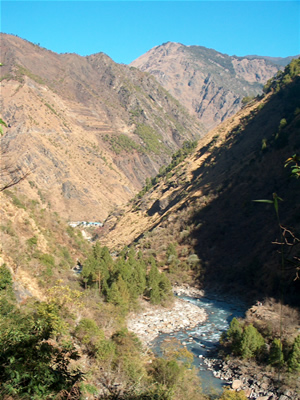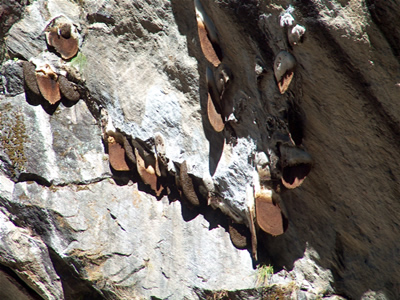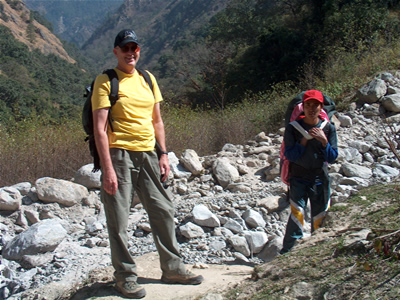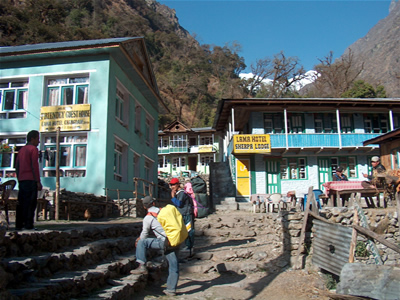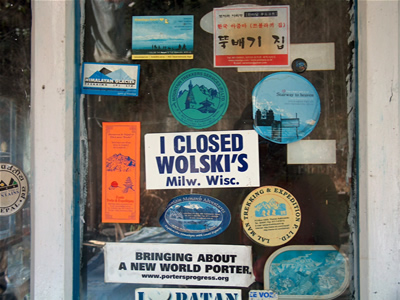Back in the Himalaya
It felt great to be starting out on a trek. The weather was wonderful. The sky was blue without a cloud in sight. It was cool but not cold, invigorating compared to the heat and humidity of Singapore. It was comfortable walking with just a long sleeve shirt. We started by dropping down about two hundred feet, crossing the river on a swing bridge and then heading up the Langtang valley. The walking was not difficult. Although the trail climbed it stayed along the river so it didn't climb too fast. Sometimes it climbed over obstacles but in general it was a gradual increase in elevation - easy hiking for Nepal. The river was a beautiful series of whitewater cascades as it dropped out of the high country.
This trek consisted of two distinct parts. The first half was a hike up the Langtang Valley and back. Starting from Syabrubensi at 4757 ft, we would take three days to hike to the high village of Kyangjin at 12,800 ft. There we would have a day to explore before turning around to hike almost all the way back down and out. A few hours after starting the trek we passed a trail junction. It was a side trail which climbed straight up the side and out of the canyon. It would be our route for the second part of the trek when we returned from Langtang. It lead to the Gosaikund Lakes and Helambu district.
Tasi pointed out something across the canyon. There was a sheer cliff several hundred feet high. In the middle of the cliff we could see huge bee hives hanging on the rocks. Their precarious position protects them from animals that would otherwise raid the hives. But humans can be quite determined and creative. The local people rappel down the cliff from above to gather honey. This was made famous in a National Geographic article back in 1988. Besides the risk of falling down the cliff the local people have no protection against the bees - they just are used to being stung dozens of times every day. This would definitely not be the job for me.
Our first lunch stop was at a tea house along the river. My table had a nice view of the river and the section of the canyon that we had climbed up that morning. It provided a feeling of accomplishment after our hours of work. Unlike the last trek where we were self contained, on this trek we ate all of our meals at lodges along the trail. Most places offered a lot of noodle dishes so I could always find something to eat. Usually the food was ok to pretty good. After all, noodles are pretty straightforward. This place was the only one that tried to improve on the noodles by putting eggs on the them. This did seem to be connected to the fact that there were several chickens running around the place and in fact several sat staring at me hoping I would drop some food. The eggs were probably a real bonus in a place like Nepal except that I can't stand to eat eggs. When I thought the hostess wasn't looking I discretely scraped the eggs onto the ground so the chickens could eat them. Unfortunately although I was quite sneaky, the half dozen chickens squawking and fighting over the scraps under my table and chair probably gave the secret away. Oh well. Between the chickens and me we finished most of my lunch. As we started to walk away I looked back and saw the lady clearing off my table. She picked up my plate and flipped the scraps onto the ground to the chickens. I guess she hadn't been too upset that I gave some of my lunch to them. They were the garbage disposal. Nothing is allowed to go to waste in Nepal.
During the afternoon we stopped for a break at a small house next to another beautiful spot along the river. There were a few seats and I was able to buy a Coke. There were local handicrafts set out on a table that were for sale: wool scarfs, carved necklaces, silver rings, bracelets, and many other items. I thought some of things looked pretty cool but I figured that the first day of a twelve day hike was not the time to buy things. That would mean that we would be carrying it a long way. I mentioned it to Tasi but he encouraged me to go ahead. His thinking was that it was better to buy from the hill people who had a tougher life than from a shop in Kathmandu. He felt that we could handle a little extra weight. That was easy for him to say as it was Khim was the one who had to carry my bag all the way and not Tasi. Typical management attitude. I ended up buying a nice green wool scarf for only 250 rupees (about $3USD). I decided that if I saw something that I liked along the way and it wasn't heavy or bulky that I would go ahead and get it. Tasi was right - the money meant a lot to the people living in the hills.
We spent our first night at Lama Hotel at 8136 ft. So even though we had an "easy" day (for Nepal) we had still gained 3400 ft. And that didn't count a few ups and downs, especially a big descent when we left Syanbrubensi right at the start.
Lama Hotel isn't a regular village. It is just a cluster of six guest houses. Kind of like a truck stop in the US (a trek stop?) It started out as a single lodge but because of its strategic location on the Langtang trail the family kept putting in additional guest houses. The one we stayed at had a large main building. It had one big room on the first floor for dining. Upstairs were individual sleeping rooms and a common bathroom (but it had a Western toilet rather than a squat toilet - real luxury!). There was also a solar shower on the first floor. Outside was an outbuilding with a huge fireplace that served as the kitchen. There was a hose that ran to the front yard that piped running water from a stream up above (make that cold water!) that could be used for washing up or doing laundry. There was even electricity in the evening in the main room. All the comforts of home.
Although the weather was perfect for hiking during the day it got cool when the sun went down. But there was a large pot belly stove in the dining room that had a nice fire in it that kept the room comfortably warm. So dinner was nice and we all stayed in the dining room for a while after dinner. The Nepalis all talked - the discussion seemed quite animated. I read my book quietly. There were only two other guests who chatted quietly in a corner. Finally it was time to go up to bed. The bedroom was cold so it was nice to have a warm sleeping bag to crawl under. The next morning when I came down for breakfast I found the couple that ran the lodge sleeping in the middle of the floor of the dining room. They had brought out a mattress and blankets and set them next to the stove. They took advantage of the fact that it was the warmest place in the building. Like I said before, nothing goes to waste in Nepal.
One final interesting note. Most of the lodges had stickers all over their windows. They usually advertised various trekking companies, hiking clubs, mountaineering gear or sometimes just weird places or things. At the Lama Hotel there was an "I Closed Wolki's" sticker. Wolski's is a famous neighborhood tavern in Milwaukee, Wisconsin (where I grew up) that is over one hundred years old and still run by the same family that started it. It is on the Lower East side near the University of Wisconsin-Milwaukee. When I was a student there many years ago I lived very close to Wolski's. I admit that I spent a few evenings there that I should have been studying. The "I Closed Wolski's" bumper stickers are very common in Milwaukee but I would not have expected to find one in a tea house in the Himalaya of Nepal. It's a small world.
